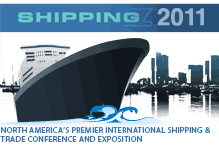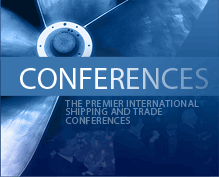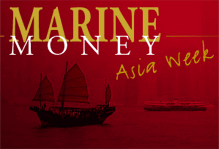
Knightsbridge Tankers – 20/20 Hindsight?
As part of our ongoing effort to assist the development of the relationship between the international shipping industry and capital markets, Marine Money recently announced a strategic partnership with Tridens LLC called Marine Securities Analysis (“MSA”), to produce independent research and advice on securities issued by companies in the marine transportation sector. We believe that recent events with Knightsbridge Tankers Limited (Nasdaq symbol “VLCCF”) point to the relevance and value of MSA.
The recent drop in VLCCF’s share price following the announcement by Shell that it would not exercise its option to extend seems in hindsight like an obvious and predictable outcome. But that was apparently not the case before the fact.
We are pleased to print the following analysis on VLCCF produced by Tridens LLC five months ago as evidence that at least one source of research had correctly assessed the situation, and had provided in-depth analysis and rationale to back it up. While many will disagree with Tridens’ outlook on the tanker market generally, its identification of structural flaws in VLCCF appears to have been spot-on. It is also interesting to note that at the time, no Wall Street firm was covering the stock, pointing to both the general importance of research and to the particular value of independent, in-depth analysis.
–Matt McCleery President, Marine Money
Off-Market Financing: Finding Hidden Money
By Matt McCleery & Gordon Fuller
Ult r apet r o l Taps into Debt & Equity at IFC…Twice
Proving our theory that shipowners who want to grow must constantly scour the world for new and alternative sources of capital, Ultrapetrol has tapped into International Finance Corporation for debt and equity… and they’ve done in twice in 2003!
We reported a few weeks ago that the Menendez family, which owns and manages high yield issuer Ultrapetrol, has continued to hustle to meet its obligations to bond holders while at the same timing growing their own businesses. To finance this growth, Ultrapetrol has tapped into a rich vein of debt and equity finance from International Finance Corporation (IFC), the private sector financing arm of the World Bank. Several months ago Ultrapetrol affiliate UABL Limited (50/50 joint venture between Ultrapetrol and beleaguered barge company ACBL) had entered into two separate loan agreements with the IFC and Kreditanstalt Fur Wiederaufbau (KFW) for a total of $40 million. The facilities are interest-only until 2005 and mature 2009 and 2011. Proceeds of the deals will be used to finance CapEx for UABL Limited for the next 3 years. Although this “CapEx” could ostensibly refer to the cash needed to develop its terminal operations, we understand that even if ACL decides to sell its stake in ACBL, the cash could not be used to provide dry powder needed for the acquisition.
Just as the ink is drying on the first IFC deal, Marine Money has learned that IFC has committed to lend $70 million to UP Offshore, a start-up shipping group with subsidiaries incorporated in Brazil and Panama that is co-owned by Ultrapetrol and the AIGGE Capital Latin American Infrastructure Fund L.P. The investment will be used by UP Offshore for the acquisition of up to six newly built platform supply vessels in order to provide transportation services to oil and gas companies engaged in exploration and production activities on the Brazilian Atlantic shelf.
STOLT-NIELSEN – ROUGH WATERS, PATIENT SHAREHOLDERS
By Daniel Ahmad
Stolt-Nielsen SA (Nasdaq: SNSA; Oslo: SNI) is to release its second quarter results on Thursday, July 10th. The company, a leader in bulk liquid transport, reported a first quarter net loss of $13 million, or $0.24 per share, on a net operating revenue of $764.2 million.
Stolt-Nielsen has been facing very serious antitrust allegations since last winter. On June 24th executive vice president Richard Wingfield was charged in a Philadelphia court with a Section 1 violation of the Sherman Act. Stolt-Nielsen immediately announced it had removed Mr. Wingfield from its conditional amnesty with the US Department of Justice, and that he had been suspended from the company.
The Wall Street Journal, which broke the story and pointed the finger at StoltNielsen last winter, reports that an FBI affidavit alleges that Mr. Wingfield and others “agreed to not compete for each others’ customers – either by not submitting prices or bids, or by submitting intentionally high prices or bids.” The FBI document states the victims of such activities have been firms such as Dow Chemical, Exxon and BP.
Reconstruction in Iraq: Implications for the Shipping Industry
By Daniel Ahmad
As a sign of anticipated growth in the post-Saddam Hussein Gulf region, Samudera Shipping Line (SSL),an Asian firm listed on the Singaporean exchange, is expanding its activities there. Last month the company, which scored third in our 2002 Marine Money Rankings, announced a new “Red Sea Service” between Jebel Ali, Khor Fakkan, Aden and Hodeida. It will be interesting to watch how the shipping industry will be affected by trade changes in the region that will develop during and after reconstruction.
Now that major hostilities have ended in Iraq, the US- led Coalition has begun its reconstruction program for the country of 23 million, which has the world’s second-largest oil reserves. The Coalition Provisional Authority, headed by Ambassador L. Paul Bremer III is to oversee these reconstruction efforts.
War is incredibly expensive. Just to maintain the 145,000 US troops operating in Iraq costs $3.9 billion per month, according to Gen. Tommy Franks. Yet war can also provide massive windfall earnings for certain industries. The Suez Canal Authority, for instance, saw its revenue from January to May 2003 increase nearly 40% from the same period the year before, due mostly to American and British war preparations. Under defense-related contracts, marine shipping companies can charge much higher rates for transporting equipment to war theatres, because of the sheer tonnage to be carried in a very short time frame, and due to the special nature of some cargos.
HORNBECK ACQUIRES FLEET IN CASH/STOCK DEAL
“Now you know why we couldn’t join you at Marine Money Week,” Todd Hornbeck, CEO of Offshore Supply Vessel, Tug and Tank Barge owner Hornbeck Offshore, said when I called him this week. The purpose of the call, of course, was to congratulate him and CFO Jim Harp on their acquisition of five 220-foot Offshore Supply Vessels (OSVs) from Kenny Nelkin’s Candy Marine Investment Corporation for total consideration of $45 million. After the transaction, B+ rated Hornbeck will have about $200 million of debt.
THE RIGHT RELATIONSHIPS ARE EVERYTHING
This deal is a good example of what can happen when a market, such as deepwater OSVs, remains down for 18 months with no immediate prospect of improvement; people leave the table, especially third party equity investors whose appetites are often finicky and who generally do not like to put up more cash. What we mean by this is that market sources suggest that Kenny Nelkin’s partner in the venture was Marcap, an entity controlled by Marmon, the leasing company controlled by the Pritzker family of Chicago. Marmon is reported to be pulling back its activities in other sectors so if they indeed wanted to be taken out of this deal it would be consistent with a larger trend. Lenders on the original Candy Marine Investment Corporation deal were Transamerica, Key Equipment Finance and BTM Capital who have all been taken out early. It is also interesting to note that this move appears to mark Kenny Nelkin’s departure from the supply boat business as he has only 2 remaining vessels, begging the question of whether the crew boats will be next.
This deal is also a good example of why it is critical for asset owning marine service companies, such as Hornbeck, to have access to liquidity through good relationships with bankers and investors. Hornbeck management did a miraculous job juggling an equity offering, overhauling and doubling a revolving credit facility while at the same time presiding over the acquisition itself. And the deal was done without financial advisors. It’s no wonder Todd Hornbeck and Jim Harp gracefully bowed out of Marine Money Week this year!
Debt Market Re-opens
By Alan Ginsberg
I am pleased to report that the Dark Period (June 1997-July 1999) is slowly drawing to a close as the Navigator Gas, Cenargo and American Commercial Lines defaults run their respective courses. By next January there may not be a single deal in default for the first time in four years. I have long posited that it would be easier to restart the game when investors were no longer focused on their defaulted positions.
Additional good news is that the high yield market is wide open for business for shipping companies, principally as a result of record inflows of funds and secondly because shipping bonds help portfolio managers fill the transportation basket of their portfolios. Given what is happening in the airline sector today, shipping bonds have never looked more attractive.
Further, there is a fair amount of turnover on the buy side. In the absence of a transportation analyst who was already covering aviation or defense, shipping often fell to the lowest (read: youngest) analyst on the totem pole. In many cases, that analyst has now either moved up or out. Depending on your point of view, institutional memory can either be a positive or a negative. To be sure, many accounts still remember the carnage and claim that they will not invest in anything less than a four “B’ credit. Others without such memory have no choice but to give the sector a fresh look.
A Circle of Friends
His blue eyes focused on mine and he said, “So,” with the no-nonsense tone for which the Dutch are famous. “What you are proposing is that Urs continue to do his job at Marine Money but DVB will now pay his salary.” Like so many things that come out of Sybren Hoekstra’s mouth, the statement was delivered as he leaned forward, head tilted slightly like a friendly but curious canine, and punctuated with the courtesy of a question mark; but it wasn’t a question.
As I looked around the table at Haru, a bustling midtown joint and favorite haunt of the local shipping bankers from Nordea, AMA and JP Morgan, I saw two gaping mouths – one belonged to Richard Janson, who seemed totally focused on lowering a giant piece of tuna sashimi into his mouth like a robin feeding its young, and the other belonged to Jim Lawrence, who was taking longer to formulate a response than is customary. Then everyone laughed and, it being a dry Tuesday affair, reached for the bowl of salty grass green Edamame.
And so began a delightful lunch with Sybren and Richard, a few days after Urs informed Jim and me that he would be leaving Marine Money after nearly three years to join the DVB team in New York. For our part, we couldn’t be happier about it. Urs has been a tremendous member of the Marine Money team; he has helped us to improve the quality of our work and I know that working on the banking side will give the ex-tanker broker and container lessor yet another perspective on the business. The fact that leading banks regularly recruit our editors is proof that our analytical skills have eclipsed our prose.
Rankings 2003 : Marking 2002 Performance
By Urs Dür
Every year the Rankings issuecauses as much controversy as applause and, hence, every year we at Marine Money try to make it better and more inclusive. The controversy arises from different interpretations of balance sheet and income (P&L) statement line items and the relevance of each of the tests to the public companies analyzed. This marks the third year that Rankings has been based on ratio analysis tests. 2000 Rankings, published in June/July 2001, had five tests over for 41 companies, with Coflexip Stena Offshore deemed the best performer. 2001 Rankings, published in July/August 2002, had 53 companies and eight tests, with D/S Torm the winner. This year, 2002 Rankings – with the dutiful assistance of Daniel Ahmad, our intern from The Yale School of Management and many years solving the world’s problems at the United Nations – consists of 60 companies – 18 having never before appeared – tested in nine ways to yield the best overall performer of 2002: Oceaneering International (NYSE: OII).
lic, traded for the full year of 2002 and had to have, by time of ranking in May 2003, printed and available income (P&L) and balance sheet statements for 2002.
A New Era for Marine Money Marine Securities Analysis & Oslo
By Matt McCleery
F irst off, we are very pleased to report that Mr. Peder Bogen will open Marine Money Oslo in August 2003! We are thrilled that he will be able to work more closely with our clients in Europe – and to manage our marketing efforts in Hong Kong, Greece and America. Peder’s Norwegian may be a little rusty after 8 years of school and work in America, so I hope our Norwegian friends will go easy on him for a while! We will miss him here in Stamford, but our clients will be better served.
Secondly, we are very pleased to announce the formation of Marine Securities Analysis (MSA). As most of our readers know, ever since Marine Money opened for business more than 15 years ago, our goal has been to use information and analysis to bridge the international shipping and finance communities for mutual benefit. In our view, nowhere is the need for that bridge currently more acute than between shipowners and the institutional investor community. Although the US has the world’s deepest pool of risk seeking equity and unsecured debt finance, shipping has been unable to fully access this market on a regular basis. Moreover, as the shipping industry enters a period of rapid and meaningful consolidation, we believe the need for equity and unsecured capital is more important than ever before.
Through our years of experience we have become convinced that the institutional investor community can, and will, provide risk capital for this cyclical industry, but only if it has access to independent, high-quality analysis. That is why we teamed up with shipping M&A boutique Tridens to create MSA.. MSA’s “point man” at Tridens is Anthony Gurnee, who is an industry leader that most of you know. Tony has worked in shipping finance covering a broad range of segments at Citibank N.A., Nedship Bank N.V., as well as CFO of Teekay Shipping Corporation. He is also a CFA Charter-holder.
Single Hull Tankers, What’s The Trick?
By Urs M Dür
I t is commonly known that the age of the single hull tanker will end as the remaining fleet is phased out by different regulatory regimes over the coming years. This is basically inevitable. Largely, the tonnage is not viable, largely for liability reasons, for most major owners and charterers over the longterm.
Still there are a large number of single hulls still trading with major charterers and making good money, especially in strong spot markets. Hence we have seen some single hulls trading hands into those who feel there is still money to be made with the design.
In this piece we will take a look at the returns available, the dynamics required to purchase such tonnage, and who is willing to finance the tonnage. We will not speculate, however, on the development of the regulatory regimes or the design of vessels as that is a discussion that is for another two articles all together.







